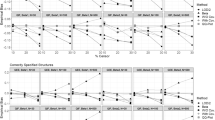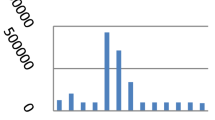Abstract
Biomonitoring involves the assessment of human or animal populations by measuring organic or biological compounds or their metabolites in the body fluids or tissues of individuals in those populations. Pooling samples before making analytical measurements can reduce the costs of biomonitoring by reducing the number of analyses. By proper choice of pooled-sample design, population means can be estimated without measuring individual samples. I present a statistical method for characterizing an entire population distribution of such compounds by exploiting the theoretic relationship between interindividual-sample variance and the variation between pooled samples. I use simulation experiments to determine an optimum pooled-sample design as a function of the number of subpopulations and the number of available samples. Using pooled samples to characterize populations is not only more cost-efficient, but also in some cases it can lead to more precise and less biased parameter estimation than that occurs with individual samples.
This is a preview of subscription content, access via your institution
Access options
Subscribe to this journal
Receive 6 print issues and online access
$259.00 per year
only $43.17 per issue
Buy this article
- Purchase on Springer Link
- Instant access to full article PDF
Prices may be subject to local taxes which are calculated during checkout




Similar content being viewed by others
References
Affymetrix. Sample Pooling for Microarray Analysis, Technical note, Affymetrix, San Diego, 2004.
Aitchison J., and Brown J.A.C. The Lognormal Distribution. Cambridge University Press, London, 1963 pp. 7–8.
Baccarelli A., Pfeiffer R., Consonni D., Pesatori A.C., Bonzini M., Patterson Jr. D.G., et al. Handling of dioxin measurement data in the presence of non-detectable values: overview of available methods and their application in the Seveso chloracne study. Chemosphere 2005: 60: 898–906.
Bates M.N., Buckland S.J., Garrett N., Caudill S.P., and Ellis H. Methodological aspects of a national population-based study of persistent organochlorine compounds in serum. Chemosphere 2005: 58: 943–951.
Bates M.N., Buckland S.J., Garrett N., Ellis H., Needham L.L., Turner D.G., et al. Persistent organochlorines in the serum of the non-occupationally exposed New Zealand population. Chemosphere 2004: 54: 1431–1443.
Bignert A., Gothberg A., Jensen S., Litzen K., Odsjo T., Olsson M., et al. The need for adequate biological sampling in ecotoxicological investigations: a retrospective study of 20 years pollution monitoring. Sci Total Environ 1993: 128: 121–139.
Caudill S.P., Wong L.Y., Turner W.E., Lee R., Henderson A., and Patterson Jr. D.G. Chemosphere 2007a: 68: 169–180.
Caudill S.P., Turner W.E., and Patterson Jr. D.G. Geometric mean estimation from pooled samples. Chemosphere 2007b: 69: 371–380.
Gleit A. Estimation of small normal data sets with detection limits. Environ Sci Technol 1985: 19: 1201–12061.
Haas C.N., and Scheff P.A. Estimation of averages in truncated samples. Environ Sci Technol 1990: 24: 912–919.
Hald A. A History of Mathematical Statistics from 1750 to 1930. Wiley Inc., New York, 1998 pp. 303–350.
Helsel D.R. Less than obvious – statistical treatment of data below the detection limit. Environ Sci Technol 1990: 24: 1766–1774.
Helsel D.R. Nondetects and Data Analysis. Wiley Inc., New Jersey, 2005 p. 58.
Hornung R.W., and Reed L.D. Estimation of average concentration in the presence of nondetectable values. Appl Occup Environ Hyg! 1990: 5: 46–51.
Huybrechts T., Thas O., Dewulf J., and Van Langenhove H. How to estimate moments and quantiles of environmental data sets with non-detected observations? A case study on volatile organic compounds in marine water samples. J Chromatogr A 2002: 975: 123–133.
Johnson N.L., and Kotz S. Distributions in Statistics: Continuous Distributions — 1. Houghton Mifflin, New York, 1970 p. 63.
Mary-Huard T., Daudin J., Baccini M., Biggeri A., and Bar-Hen A. Biases induced by pooling samples in microarray experiments. Bioinformatics 2007: 23: i313–i318.
NCEH First National Report on Human Exposure to Environmental Chemicals (NCEH Publication 01-0164, 2001).
NCEH Second National Report on Human Exposure to Environmental Chemicals (NCEH Publication 02-0716, 2003).
NCEH Third National Report on Human Exposure to Environmental Chemicals (NCEH Publication 05-0570, 2005).
Odeh R.E., and Owen D.B. Tables for Normal Tolerance Limits, Sampling Plans, and Screening. Marcel Dekker, New York, 1980 pp. 17–69.
Persson T., and Rootzen H. Simple and highly efficient estimators for a type I censored normal sample. Biometrika 1977: 64: 123–128.
Travis C.C., and Land M.L. Estimating the mean of data sets with nondetectable values. Environ Sci Technol 1990: 24: 961–962.
Weinberg C.R., and Umbach D.M. Using pooled exposure assessment to improve efficiency in case-control studies. Biometrics 1999: 55: 718–726.
Zhang S.D., and Gant T.W. Effect of pooling samples on the efficiency of comparative studies using microarrays. Bioinformatics 2005: 21: 4378–4383.
Acknowledgements
I thank W. E. Turner, D. G. Patterson Jr., J. L. Pirkle, and E. J. Sampson for access to individual measurements of National Health and Nutrition Examination Survey samples and for making possible the pooling of samples.
Author information
Authors and Affiliations
Corresponding author
Additional information
Supplementary Information accompanies the paper on the Journal of Exposure Science and Environmental Epidemiology website (http://www.nature.com/jes)
Rights and permissions
About this article
Cite this article
Caudill, S. Characterizing populations of individuals using pooled samples. J Expo Sci Environ Epidemiol 20, 29–37 (2010). https://doi.org/10.1038/jes.2008.72
Received:
Accepted:
Published:
Issue Date:
DOI: https://doi.org/10.1038/jes.2008.72
Keywords
This article is cited by
-
Exploration of urinary metabolite dynamicity for early detection of pregnancy in water buffaloes
Scientific Reports (2022)
-
The porcine respiratory microbiome: recent insights and future challenges
Animal Microbiome (2021)
-
Global gene expression profiling using heterologous DNA microarrays to analyze alterations in the transcriptome of Mus spretus mice living in a heavily polluted environment
Environmental Science and Pollution Research (2016)
-
Cross-sectional biomonitoring study of pesticide exposures in Queensland, Australia, using pooled urine samples
Environmental Science and Pollution Research (2016)
-
Spatial and temporal trends of the Stockholm Convention POPs in mothers’ milk — a global review
Environmental Science and Pollution Research (2015)



